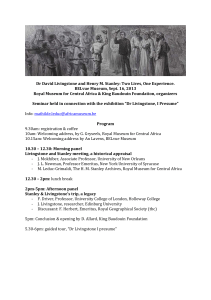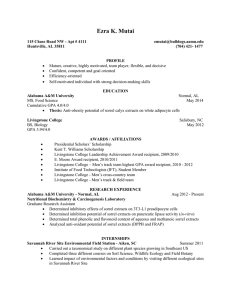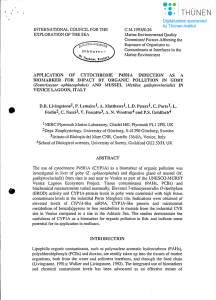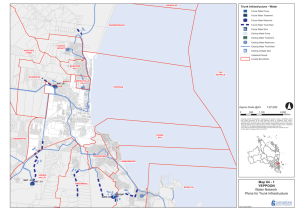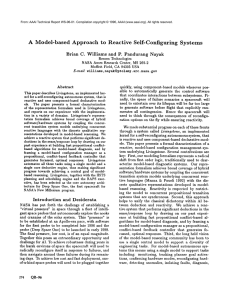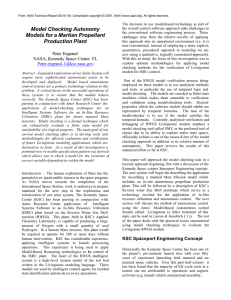*Out with old and in with the new* The need for sociology of
advertisement
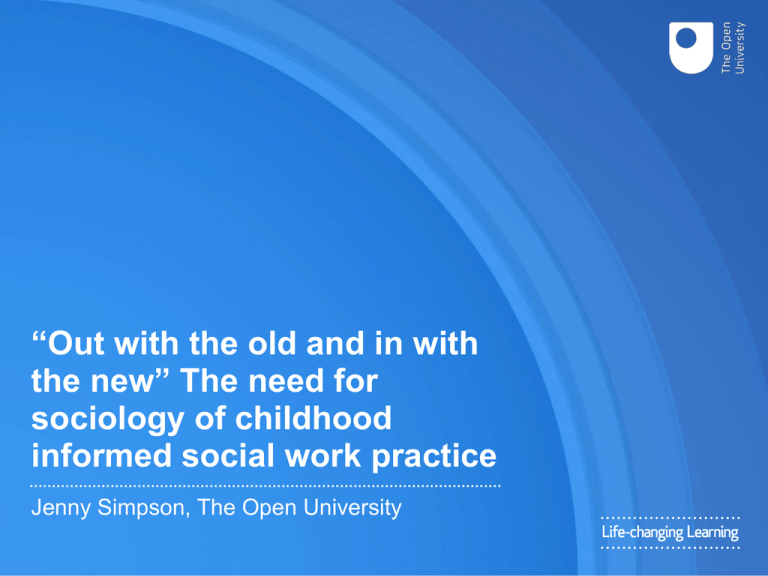
“Out with the old and in with the new” The need for sociology of childhood informed social work practice Jenny Simpson, The Open University Background The challenges facing fostering social work ● Young people in foster care being unsettled and their placements being undermined by manipulative behaviour of birth parents (Stephenson, 2009) ● Young people in care being victims of cyber-bullying (Fursland, 2011) ● Young people in care are vulnerable to sexual exploitation either by an individual or via a gang. The majority of victims are female (Sen, 2015) ● Limited or lack of access to different social networking platforms which are frequently used by the majority of young people (Fursland, 2011) ● Significant divergence of opinions held by social work practitioners as to how best to respond to concerns raised by foster carers and other professionals (Fursland, 2011) ● The possible risks and threats stemming from mobile devices and the Internet are external to the home environment (Fursland, 2011) 2 Background The challenges facing fostering social work ● Risks associated with smartphones that include: inappropriate tagging of photographs, geolocation and complex gifting, for example sharing of music and photographs that might be of a pornographic nature (sexting) (Carrick-Davies, 2011) ● Many of the risks faced by young people come from outside the home and are situated in peer groups and neighbourhoods. Parents and practitioners are struggling to effectively manage these risks as the existing child protection system has been designed to deal with risk emanating from the familial environment (Lenhart et al., 2011 and Firmin, 2013). ● Child protection processes that are used for young people are likely to be inappropriate as their immediate circumstances include multi-faceted problems that are difficult and require a different response. This is because of the expansive range of risks identified as external to the home combined with existing risk-taking behaviours exhibited by the young people themselves (Gorin and Jobe, 2013) 3 Background The challenges facing fostering social work 4 Background The risks experienced by young people in general are: ● Content: type of material that is available to download, view and generate e.g. pornographic, suicide and self-harm websites ● Contact: this may involve an individual who is online encouraging a young person to take part in an interaction either online or offline which leads to risky behaviours ● Conduct: this may include the young person being both a victim and also a perpetrator e.g. cyberbullying (May-Chahal et al., 2014) 5 Key developmental tasks Benefits of the Internet and social networking for young people ● There is a wish to maintain communication not only with friends but also a wider circle of people (Livingstone, 2011 and boyd and Marwick,2011) ● Meeting a fundamental need of adolescent development by satisfying some requirement for attachment through a variety of relationships. ● Performance on the social media ‘stage’ draws the attention of peers but also enhances personal worth and standing amongst them and serves as a means to obtain social capital Key adolescent development tasks are being achieved: identity, autonomy and sexuality (Hill, 1983 as cited by Subahmanyam and Greenfield, 2008) 6 Summary Vulnerability vs. Risk ● The case between vulnerability and risk is not entirely straightforward (McLeod, 2007; Livingstone and Brake, 2010; Livingstone, 2011; Livingstone et al., 2012) ● Carrick-Davies (2011 p.15) has commented that the ‘significance of the mobile phone in the often complicated inter-relationships of young people characterises their lives and perception of risk’ ● Research undertaken by Livingstone et al., (2012) suggests that young people’s use of the Internet when it was managed by monitoring software, tended not only to impair online skills, but also digital skills and opportunities that would provide them with the opportunity to maintain their safety. “the exact relationship between online and offline vulnerability still needs to be better understood and the evidence does not support an assumption that young people with care experience are per se, at greater risk online” (Sen 2015) 7 Models of social work Psychologically Informed Social Work Sociology of Childhood Draws on theoretical approaches that include systems, ecological and attachment theories Emphasises that children are able to contribute and co-construct our adult understanding of childhood Manifested in securing the individual safety of the young person in care and protecting childhood Acknowledges that children and young people have agency Pathologises the behaviours of the young person in care Can embrace a citizenship based approach which readily acknowledges that children and young people have rights Supports the normative assumptions about children and young people that have been principally informed by Paiget (1953) regarding their cognitive development Offers the opportunity for social workers to understand the young person in care’s experiences of risk through their own narrative account and then go on to analyse the contextual phenomena (Carrick-Davis, 2011) Supports the dominant narrative that relates to children and young people being governed by basic wishes, fantasies and fears Enables the wishes and feelings of the young person in care to be taken into account and given respect Ultimately leads to practitioners like social workers failing to critically reflect and question the dominating narratives Promotes safeguarding that is much more child-centred Does not easily allow for the experiences of young people in care to be recognised or accepted 8 Why the need for change? ● Risk as it understood presently is outside of the family home ● May be necessary for social work practitioners to realise that young people can and are experts of their lives, and are able to “engage in feasible opportunities to learn and train, to help others, or to participate in decisions that affect them” (Hanson and Holmes, 2014 p.22) ● Provides a framework within which social work practitioners and young people in care are capable of sharing common goals in relation to safeguarding ● There may be certain risks that are meeting the development needs of a young person in care in the here and now (Hanson and Holmes, 2014) ● Munro’s (2011 p.105) recommendation that social work organisations need to give credence to the views and experiences of both children and the social work practitioners that work alongside them. 9 Questions ? 10 References boyd, d. and Marwick, A. Social privacy in networked publics: Teens attitudes, practices and strategies. A decade in Internet time: Symposium on the dynamics of the internet and society. Oxford: Oxford Internet Institute. Carrick-Davies, S. (2011) Munch, poke, ping: Vulnerable young people, social media and E-safety. London: Teacher Development Agency Department for Education (2014) Rethinking support for adolescents in care or on the edge of care: Department of Education’s Children’s Social Care innovation programme. London: The Stationery Office Firmin, C. (2013) We are failing to respond to the risks faced by teenagers. The Guardian. http://www.theguardian.com/society/2013/nov/26/child-protection-failing-teenagers-risk Fursland, E. (2011) Foster care and social networking: A guide for social workers and foster carers. London: Association of Adoption and Fostering. Hanson, E. and Holmes, D. (2014) That difficult age: Developing a more effective response to risks in adolescence. Dartington. Research in Practice Lenhart, A.; Madden, M.; Smith, A.; Purcell, K.; Zickuhur, K. and Raine, L. (2011) Teens, kindness and cruelty on social network sites: How American Teens navigate the new world of digital citizenship. Washington DC: Pew Internet and American Life Project. 11 References Livingstone, S. (2011) Social networking: Risks and opportunities for youth. Child and welfare Technology pp.23 http://cascw.umn.edu/wp-content/uploads/2013/12/CW360_2011.pdf Livingstone, S.; Olafsson, K.; O’Neill, B. and Donoso, V. (2012) Towards a better Internet for children. EU Kids Online. http://www2.lse.ac.uk/media@lse/research/EUKidsOnline/EU%20Kids%20III/Reports/EUKidsOnlinereportfortheC EOCoalition.pdf May-Chahal, C.; Mason, C.; Rashid, A; Walkerdine, J; Rayson, P. and Greenwood, P. (2014) Safeguarding Cyborg Childhoods: Incorporating the on/offline behaviour in every day social work practices. British Journal of Social Work 44 pp.596-614 Munro, E. (2011) The Munro Review of Child Protection: Final Report: Child Centred System. London. Department of Education Sen, R. (2015) Not all that is solid melts into air? Care experienced young people, friendships and relationships in the ‘Digital Age’. British Journal of Social Work Advance Access pp1-7 DOI:10.1093/bjsw/bcu152 The Association of Directors of Children’s Services (2013) What is Care For – Alternative Model of Care for Adolescents. London: The Association of Directors of Children’s Services. http://www.adcs.org.uk/download/positionstatements/2013/ADCS_position_statement_What_Is_Care_For_April_2013.pdf 12

